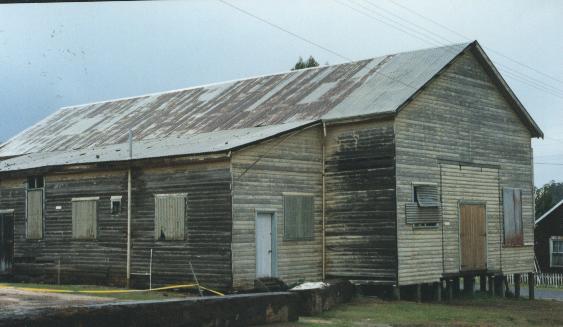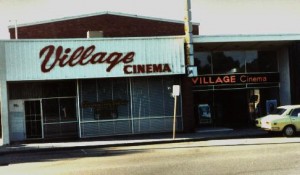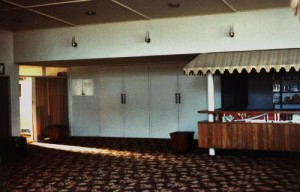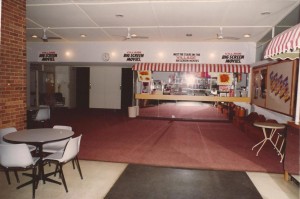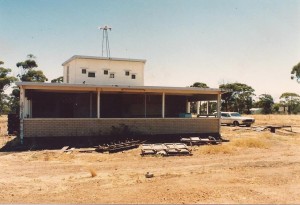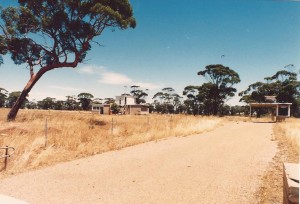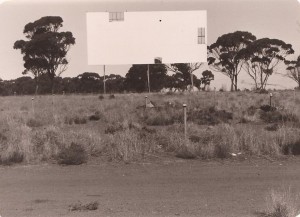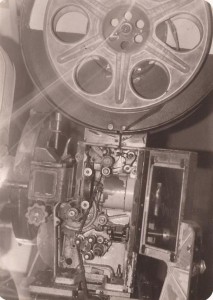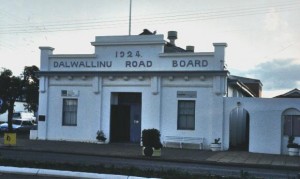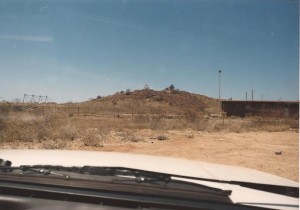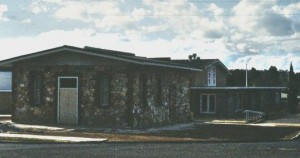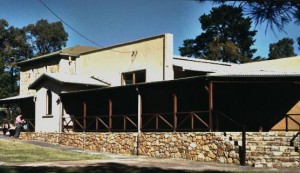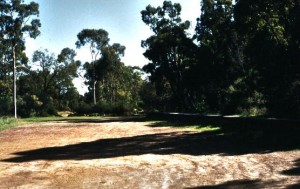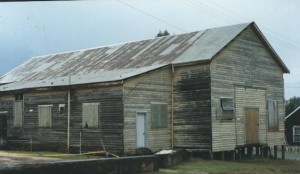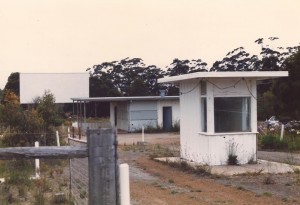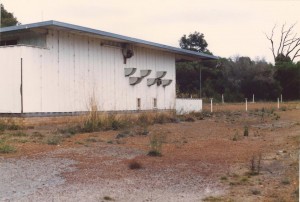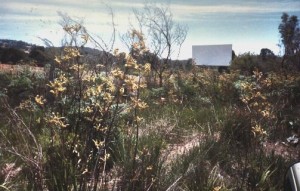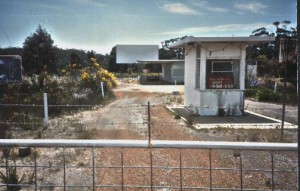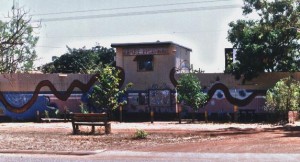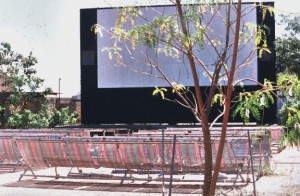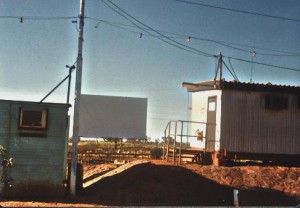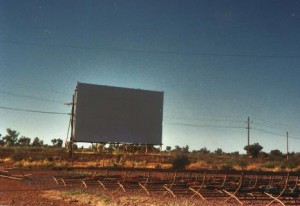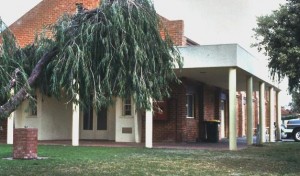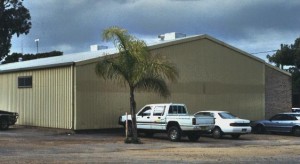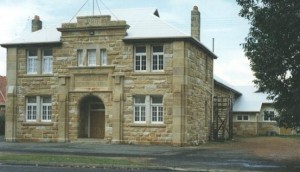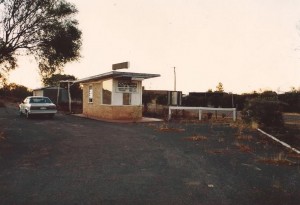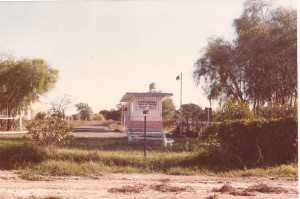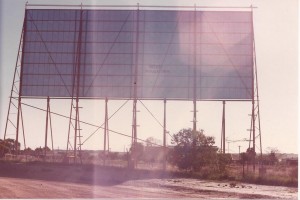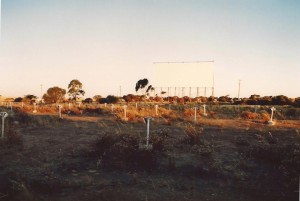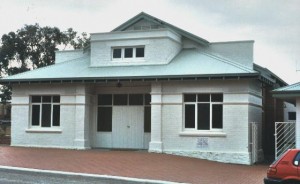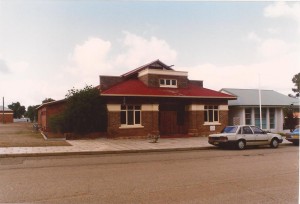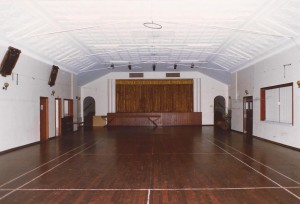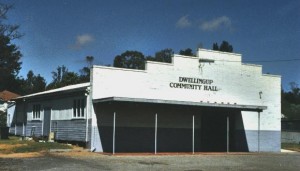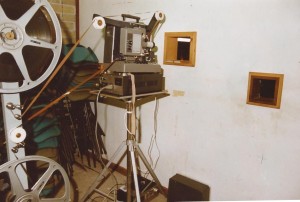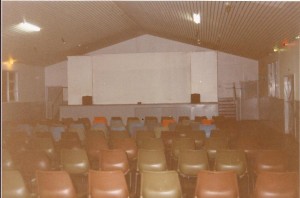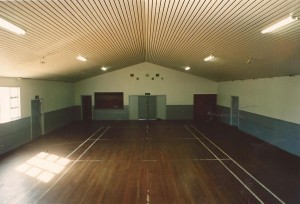Quicklinks
| Dalkeith | Dalwallinu | Dampier |
| Dangin | Darkan | Darlington |
| Datatine | Deanmill | Denmark |
| Derby | Dixvale | Dongara |
| Donnybrook | Dowerin | Dumbleyung |
| Dunsborough | Duranillin | Dwellingup |
DALKEITH
DALKEITH AND GARDENS/ VILLAGE/ REVUE TWIN, 81/95 Waratah Ave, Dalkeith
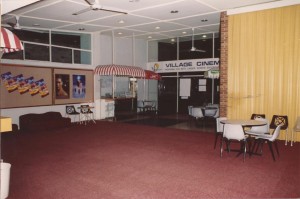
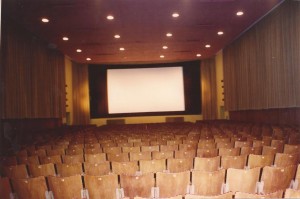
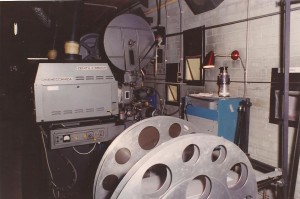
Not to be confused with an earlier Dalkeith Picture Gardens (see 122 Stirling Hwy, Nedlands), this Dalkeith Picture Gardens opened with 500 seats in 1945 at 81 Waratah Ave, on the corner of Adelma Rd. Part of the gardens could be closed in during winter by the erection of pre-fabricated panels, which Ross Thorne describes thus:
When the open air portion was to be used the end wall, upon which was affixed the screen, slid aside so the projection beam continued through the yard to reflect off another white rectangle painted on the flat iron fence. The end wall was left open permanently when a more comfortable enclosed cinema was constructed further down the road.
The interior half of the Dalkeith was constructed in timber stud framing with ceilingless iron roof and bitumen covered earth floor. The Gardens’ exterior was a misnomer for ¬any garden quality could only have been a figment of one’s imagination, taking into account the symbolic nature of the green paint on the sheet iron fence. (Ross Thorne, Cinemas of Australia via USA, p.237)
The building down the street (at no.95, referred to above) held 3-400, and was operated in conjunction with the gardens (at no.81) from 1954. In 1968 the hard-top cinema was completely refurbished and re-opened as the Village Continental Cinema, one of the Ace circuit. It now held 688, and was described as:
…first of Perth’s new and intimate suburban houses…
Plush carpeting abounds, seating is staggered and allows more than usual leg room between rows. The Village is fully air-conditioned, and tasteful full-length drapes cover the side walls, with a wrap-around gold curtain encompassing the screen. (Film Weekly, 18 April 1968)
The opening programme – A Man and a Woman – indicated a continental or arthouse programming policy, which was to see the theatre through the difficult days of the post-television depression in the industry. In the eighties it was still an Ace Theatre, but reverted to general programming, and was sub-let to various independent operators (including James Woods of Westralian Drive-ins). It closed intermittently in the nineties, but was used sometimes for film screenings for the Festival of Perth. The building was sold to a local supermarket in 1994, but films were still presented for some time until the cinema was closed while plans were drawn up first to turn it into a triple cinema, including putting a new cinema on the roof, then – less ambitiously – to turn it into a twin cinema. This finally opened on 21 November 1996, as a twin cinema but at first with only one screen in operation. It was known as the Revue, and by 1999 both screens were in operation.
A popular feature in recent years is the adjacent bookshop café, specialising in cinema and related publications. In 2000, it was reported (Kino 72)that the Dalkeith Revue was under new management, no longer associated with Palace Cinema Group. In 2001 it was reported (Kino 78) that the ‘Revue Twin no longer functions as a cinema, but re-opened this week as a warehouse selling furniture and bric-a-brac. Cinema 1 has had all the seats removed, but the owners want the screens and projectors to remain in situ. Some seats have been retained in Cinema 2, which is rented out to a Choir of 250 voices.’
Sources: Public Health Department, building permit, Battye 1459
Max Bell, Perth – a cinema history, The Book Guild, Lewes, Sussex, 1986, pp.49, 57-8
Max Bell, ´Village cinema, Dalkeith’, Kino no.21, September 1987, p.14
Max Bell, ´Dalkeith Picture Gardens’, Kino no.16, June 1986, p.22
Ross Thorne, Cinemas of Australia via USA, p.237
Australasian Exhibitor, 14 March 1968, p.5; 18 April 1968, p.3
Film Weekly, 18 April 1968, p.1
Film Weekly Directory, 1948 – 1971
Kino, no.35, March 1991, p.24; no.38, December 1991, p.27; no.40, June 1992, p.26; no.43, March 1993, p.31; no.50, December 1994, p.35; no.51, March 1995, p.31; no.55, March 1996, p.31; no.57, September 1996, p.31; no.58, December 1996, p.31; no.59, March 1997, p.31; no.60, June 1997, p.35; no.72, Winter 2000, p.43; no.78, Summer 2001, p.55
Post Office Directory, 1947, 1949
West Australian, 1945 – 1969, 1999 – 2000
Photos: 1 exterior, b&w, 1968, Film Weekly 18 April 1968, p.1
1 exterior, b&w, 1980, Kino no.21, p.14 (Max Bell)
1 exterior (Village), colour, 1981 (Bill Turner)
1 interior (foyer), colour, 1981 (Bill Turner)
1 exterior (gardens 1980), Kino no.16, p.22 (Max Bell)
1 exterior (gardens site 1981), colour (Bill Turner)
2 exterior, colour, 1993, Roy Mudge
2 interior including projection equipment, colour, 1993, Roy Mudge
DALWALLINU
DALWALLINU DRIVE-IN, Strickland Drive, Dalwallinu
Paddy Baker built the drive-in at Dalwallinu, on land leased from the Shire, south of the Hospital grounds, opposite where Anderson Way and Shannon Sts enter Strickland Drive. The venue opened in 1967, holding 140 cars. From about 1981 till it closed it was operated by Alan Murray on Saturday nights only.
It was not as successful as the gardens, and was closed about 1983. Paddy Baker planned to hand it over to the local Lions Club: on the day he was to visit the town to make this official, the gentleman who was going to take him found him dead at the foot of the stairs of the Regal Theatre, Subiaco. John Marsden then took over the drive-in, installed a manager on site but did the booking himself for about 3 months until it was too much, so he closed it, and gave the equipment to the Apex committee.
In 1997, the Council still owned the land. The brick concession building with the cement-sheet bio-box above was still standing, used as a storage facility by the Lions Club: the rest of the site was used as a BMX track for local children.
Sources: Film Weekly Directory 1968/9 – 1971
Public Health Department, building permit, Battye 1459
Max Bell, Perth – a cinema history, The Book Guild, Lews, Sussex 1986, p.133
Max Bell, Kino, no.13, September 1985, p.14; no.15, March 1986, p.22
Interviews (Ina Bertrand): Alan Larkin (1985), John Marsden (1997)
Interview (Peter Morris): Paddy Baker (1978)
Informants: Jessie & Bill Atkinson (1997)
Photos; 2 exterior, colour, 1987, Roy Mudge
1 exterior ( screen) sepia, 1980’s Max Bell
1 Bio Box , sepia, 1980’s, Max Bell
OPEN AIR THEATRE, McNeil St, Dalwallinu
After he began screenings in the hall, Ray Dean also opened an open air theatre on the south-west corner of the intersection of McNeil and Rainer Sts. It was a simple, functional venue – it could not be anything else until after the water scheme began in 1965, allowing more attention to the planting of trees and shrubs. It was surrounded by a high corrugated iron fence, with the screen at the west end of the block, and entrance on McNeil St, next to the ticket box. The floor was simply level gravel. There were some wooden seats at the front, used mainly by children, but most of the patrons sat on canvas deckchairs. It was well-attended, in fact usually full at Saturday night screenings, and was at some stage extended into a second block next door.
It opened in the late fifties (possibly 1957), and closed when Paddy Baker opened the drive-in in 1967. In 1997, the land was used for the Catholic Church and presbytery on the corner block, and by Telstra on the second block.
Sources: Interview (Ina Bertrand): Ray Dean (1997)
Informants: Jessie & Bill Atkinson (1997)
ROADS BOARD HALL, Johnston St, Dalwallinu
Dalwallinu is mainly a farming community, at the northern end of the wheat belt. The town has been slowly growing, particularly after the water scheme was introduced in 1965 and electricity became available, and the town land is nearly all used up. When Jessie and Bill Atkinson came to live in the town in 1948 there was only a small primary school, staffed by the head teacher and two assistants: in 1997 there was a large regional high school. A number of Plymouth Brethren (whose beliefs prevent them from attending films) have made their home in Dalwallinu, but there have always been plenty of other residents enthusiastic about the pictures. It was a good location for an exhibitor, as the nearest competition would have been in Wongan Hills or Moora.
The Roads Board Hall in Dalwallinu is a sturdy stone building on the north-west corner of the intersection of Johnston St (the town’s main street, at that point part of the Great Northern Highway) and Myers St. It was built in 1924, and was probably used for pictures from the beginning as it had a built-in bio-box. Certainly R. Woods was screening in Dalwallinu, presumably in the Roads Board Hall, in 1928, and local pianists provided an accompaniment to the silent films.
In the early thirties, the local doctor (Colin Anderson), who was also a film enthusiast, organised film screenings in the hall, with the work done by volunteers and all profits going to the hospital. The first open air screenings in the town were by this group, on the open ground beside the hall, where the supper room and Shire Offices now stand.
Tom Nulsen’s ´The West Touring Talkies’ operated out of Dalwallinu from 1936, and was purchased by Ray Dean in 1940, who renamed the circuit West Talkies. Dean screened in the hall every second Saturday, before building the gardens. Lew Punch’s Travelling Talkies visited the town in the fifties, and again probably used the Roads Board Hall. It is not clear whether it continued to be used for regular film screenings in conjunction with the gardens, or whether the gardens screenings replaced it. Vic Basham bought the business from Punch, and operated it as part of his circuit, based in Wongan Hills, closing the venue after the drive-in was built.
The old hall still stands, next to the newer Shire Offices (though in 1997 there were plans to replace these, building on the railway reserve across the road). The rooms on the street frontage, on either side of the entrance, are used as offices and the hall itself is used for community activities such as indoor cricket and a ballet school. It is also occasionally hired for 16mm film screenings (as the bio-box is no longer operational), to raise money for church and charitable groups.
Sources: Film Weekly Directory 1940/41 – 1960/51
Post Office Directory 1944-47
Everyone’s, 1 February 1928, p.16
Interviews (Ina Bertrand): Vic Basham (1997), Ray Dean (1997), Alan Larkin (1985)
Correspondence with Judy Love, Mundaring and Hills Historical Society, including notes of interview with Lew Punch
Informants: Jessie & Bill Atkinson (1997, 1998)
Photo: 1 exterior, colour, 1997, Graeme Bertrand
DAMPIER
OPEN AIR PICTURES, Esplanade, Dampier
The town of Dampier was a company town, built for Hamersley Iron Pty Ltd to accommodate its employees and their families. The town is the port for the mining operations at Tom Price and Paraburdoo, and the first houses were built there around 1963-5. The first picture show opened soon after – in the open air, behind Poon’s mess (now the Sea Scouts).
The company provided all the facilities for the town, including sporting and entertainment facilities. So, in 1968, a new screening venue which could hold about a hundred people was constructed on the Esplanade, between the car park and the beach, just north of the boat ramp. The picture shows were run at first by the Dampier Community Association, assisted by the company. Later Jim Woods, of Westralian Drive-ins, was contracted to run the show. A simple cyclone wire mesh fence surrounded the area where patrons sat on moulded plastic chairs, arranged in permanent rows. Some cars could drive right up close to the back fence and receive the sound on their car radios, tuned to a low frequency, but cars further back could not do this. The screen was at the west end, backing onto the sandhills.
The population of the town held steady around 2,500 throughout the seventies and eighties, but the cinema closed in 1982, not long after a cyclone had devastated the screen. All that was left in 1997 was a red brick building (that housed the concession area, the toilets, and the biobox), standing in a sea of decaying bitumen. The only films at that time in the town were occasional fund-raising screenings for the local school.
Sources: Film Weekly Directory 1968/9 – 1971
Public Health Department, building permit, Battye 1459
West Australian 1981
Interviews (Ina Bertrand): N.J.Woods (1985), Noel Wright & Diane Lockett (1997)
Informants: Geoff Cole (1997), Hazel Moyle (1997)
DANGIN
DANGIN AGRICULTURAL HALL, Parker St, Dangin
The townsite of Dangin was within the estate of the Parker family, with entry only through gates on this property. The Agricultural hall was constructed on land donated by the Parkers, and the foundation stone was laid in 1909 by Mrs Lilian Parker.
Regular weekly film screenings were conducted here from 1928 to 1936 by the Dangin Picture Company, with Hadlow as chairman and Halford as secretary (which sounds as if this was a community enterprise).
When the town of Quairading became the commercial centre of the district, the fortunes of Dangin declined, and in 1997 there was very little left of the once thriving community. The hall was demolished after being sold by the Quairading Roads Board to a local resident, and the site is now vacant, though marked by a Heritage Trail plaque.
Sources: Shire of Quairading, Municipal Inventory of Heritage Places, no.150
Frances Eaton, The golden grain and the silver fleece: a history of Quairading from 1859-1930 , Shire of Quairading 1979, p.19
Everyone’s, 28 March 1928 p.28
Photo: 1 exterior, b&w, n.d., Shire of Quairading, Heritage trail plaque (on the site at Dangin).
DARKAN
DARKAN PIONEER HALL, Hillman St, Darkan
The Pioneer Hall was built by George Cuthbert on the north-west corner of the intersection of Hillman & Butler Sts in 1910. It was built of local stone and brick, with a timber floor and corrugated iron roof. At one stage the stonework was cement-rendered, but in 1997 that had recently been removed. A new hall was built beside the old one in 1964.
Both these halls were used for films at various times, on Lew Punch’s circuit around 1950 and on A.H.Jeffries’ circuit in the early sixties.
Sources: Film Weekly Directory 1950/51 – 1951/2, 1960/61 – 1964/5
John Bird, West of the Arthur, West Arthur Shire Council 1990
Ida Spencer, Darkan (Western Australia): early days – One hundred years of Darkan’s history 1862-1962 , no publication details (preface dated 13.9.66)
Shire of West Arthur, Municipal Heritage Inventory, No.22
Interview (Ina Bertrand): Eddie Wheeler (1997)
Photos: 1 exterior, b&w, 1996, Shire of West Arthur, Municipal Heritage Inventory, No.22
1 exterior, b&w, n.d. (1966?), Ida Spencer, Darkan (Western Australia): early days – One hundred years of Darkan’s history 1862-1962, no publication details (preface dated 13.9.66), p.28
1 exterior, colour, 1997, Graeme Bertrand
DARLINGTON
DARLINGTON PICTURES, Beenong Rd, Darlington
There are advertisements for pictures at Darlington in 1947-8, which were probably screened in the Darlington Community Hall, on the western side of Beenong Rd, between Maslin Cres and Owen Rd, but it is not clear who was conducting the show. The northern section of Darlington in the fifties was still a weekend resort for Perth’s upper class, but the permanent residents (mostly south of the railway line) were a small community of about nine hundred, isolated by inadequate public transport and with few families owning cars. Community activities were important, and well-patronised.
Around 1956, Tom Pilmoor took over responsibility for the Darlington Younger Set – a youth group for thirteen to twenty-one year olds. At first committee members took turns to supply different activities for their Friday nights in the Community Hall – dancing lessons, lectures, or whatever the person could provide. But this proved unreliable, and these activities were replaced by regular film screenings. These were organised by the young people themselves, under Pilmoor’s supervision: so, the films were chosen by the members of the group, booked by Tom Pilmoor, collected and returned by the members. The secretary of the group, Charles Adderley, was projectionist.
The hall was a small stone building, and a bio-box was erected inside, above the hall entrance, supported on props. But the screenings were so successful that it was decided to construct an open-air venue between the hall and Beenong Street. Tom Pilmoor, who was a carpenter, constructed the 12ft by 18ft screen, out of 3in x 2in dressed timber, covered by sheets of flat iron, screwed on and painted white (by the boys of the Younger Set). Metal-frame deckchairs seating about a hundred people were in the hall from earlier screenings: each held five people, and new individual green-and-orange striped canvas covers were made.
Though the money raised went to the Younger Set, these screenings became a community activity, attended by all the family, with the adults seated on the deckchairs and the children on the grass in front. Screenings ceased in 1960, after television arrived. The hall was later extended and in 1997 was in use as a Montessori School.
Sources: West Australian, 1947 – 1948
Interview (Ina Bertrand): Tom Pilmoor (1997)
Photo: 1 exterior, colour, 1997 (Graeme Bertrand)
DRIVE-IN, Brook Rd, Darlington
After screenings ended in the hall, Phil Harris put up a screen at the western end of the railway reserve, alongside the disused railway station platform. Cars drove in from Brook Rd, opposite the Post Office, and lined up facing west. Sound was provided by loudspeakers. This venture lasted only a few months.
Sources: Interview (Ina Bertrand): Tom Pilmoor (1997)
Photo: 1 exterior, colour, 1997 (Graeme Bertrand)
DATATINE
HALL, Datatine
Datatine is between Dumbleyung and Nyabing. Silent films were screened at the Datatine Hall irregularly (about every three months), in the twenties. The operator brought a generator with him in his bus.
Sources: Informants: Autumn Club, Katanning (1997)
DEANMILL
DEANMILL HALL, Bryce St, Deanmill
Deanmill is a small timber milling settlement, the mill operated in the nineties by Bunnings. There are rows of identical timber houses constructed for the mill workers, and a timber hall was also built, in Bryce St, on the corner of Cox St, behind the school (which faces Towie St).
West’s Pictures (run by local F.E.West, not the city entrepreneur T.J.West) screened in Deanmill in the twenties, as part of a small circuit operating out of Manjimup.
But Deanmill was also the place where Allan Jones, who became the doyen of exhibitors in the district round Busselton, began in the picture business. He had been working at the mill at Deanmill, and wondering what else to do to make his mark. His first venture was a hire car, specialising in getting people to the doctor at Jardee or the main district hospital at Bunbury. Then he decided that there was money in pictures, and persuaded the mill manager to allow him to use the steam-driven generator at the mill for screenings. His first programme was presented on 13 July 1923, but a year later the mill was destroyed by fire and he decided to go on the road as a travelling showman. His first circuit was quite modest – Deanmill, Jardee, Dixvale and Bridgetown. He was not immediately successful – in fact he had to return intermittently to mill work to keep financially afloat. But he persevered, and by the early fifties he had four vans covering at various times almost thirty towns, always including Deanmill. Facilities were rather primitive: in his Reminiscences Allan Jones describes the seating as ´a few wooden chairs, a small number of backless forms, and PLENTY of floor space’.
Jones screened at Deanmill till the mid-sixties, and in the nineties, the hall is derelict, but still standing.
Sources: Film Weekly Directory 1940/41 – 1964/5
Max Bell, Perth, a cinema history, The Book Guild Ltd, Lewes, Sussex 1986, p.96
Allan Jones, Reminiscences of a Travelling Picture Showman , Busselton 1974
Interview (Ina Bertrand & Irma Whitford): Allan Jones (1978)
Mrs D.Jones to Colleen Pead (1985)
Photo: 1 exterior, colour, 1997, Graeme Bertrand
DENMARK
DENMARK DRIVE-IN, Brazier St, Denmark
Joe Rourke replaced his hall screenings with a drive-in on the Recreation Reserve leased from the Council. This opened in February 1965, with capacity for 140 cars. It had Simplex projectors with 14″ arcs and a screen built by Melville Engineering. There was a small cafe, where take-away food was served before the show and at interval: the sit-in area was under the cafe verandah. The boys from the Agricultural College, who did not have cars, would bring in their sleeping-bags to make sitting in the open air more comfortable. The venue screened four nights a week, with three changes of programme (Wednesday, Friday/Saturday, Sunday).
When Joe Rourke died, in 1972, the lease was taken over by Tom Knight and Phil Smith of Albany Investments (who also operated the Orana in Albany). The venue closed in the early eighties. In 1997, the huge Recreation Centre had been built next door, but the drive-in site was still vacant, with the derelict bio-box still standing.
Sources: Film Weekly Directory 1965/6 – 1971
Public Health Department, building permit, Battye 1459
Max Bell, Perth – a cinema history, The Book Guild, Lewes, Sussex, 1986, p.134
Albany Advertiser, 22 January 1965, 8 February 1965
Great Southern Herald , 10 April 1964
Interviews (Ina Bertrand): Tom Atkinson and Denmark Historical Society members (1997), Brian Rourke (1997)
Photos: 2 exteriors, colour, 1985, Robert Newton
3 exteriors, colour , 1988 , Roy Mudge
DENMARK HALL, Strickland St, Denmark
The Denmark Hall was constructed of timber, before the turn of the century. Weekly screenings were conducted there in the early thirties by a local man, Lionel Alexander, screening on the same night and in competition with the Atkinsons at the Londesborough. While it was used as a picture theatre, it was called the Empire Theatre, and on other nights the hall was used for dances and concerts.
In about 1938, Joe Rourke took over these screenings, and continued here till about 1942, when he transferred to the Londesborough: the Denmark Hall then became a dormitory for the students at the Agricultural College.
It was later demolished and the present Civic Centre is built on the site.
Sources: Interview (Ina Bertrand): Tom Atkinson and Denmark Historical Society members (1997), Brian Rourke (1997)
Informant: Mrs Rourke (1997)
Photo: 1 exterior, b&w, n.d., Denmark Historical Society
LONDESBOROUGH THEATRE, South Coast Highway, Denmark
The Londesborough Theatre was built in the V-intersection of North St with the South Coast Highway, in 1925. It was constructed for Robert Atkinson and his sons, who ran the pictures here till about 1942, as one of their many business ventures in the town. It was a simple timber structure, with a corrugated iron roof, so very noisy in the rain. It had a bio-box built on pillars inside, and a stage for live performances. Adults sat in padded seats at the back, children in hard seats at the front. There was no kiosk in the theatre – the audience patronised Ricketts shop, where they also booked seats. Toilets were located outside, behind the building: two cubicles for ladies, one for men. The power plant was also located in a shed at the back of the hall, in the days before the town had a municipal power supply.
In the silent days, Ada Hard played the piano accompaniment. She was deaf, and in the habit of forgetting to watch the screen, so synchronisation of mood between the image and music was rather erratic.
Screenings were twice a week – on Thursdays and Saturdays. Robert Atkinson ran a bus for patrons from the nearby Group Settlement areas, which had been opened up in 1922: their bus ticket was also their ticket to the picture show. Among the Denmark Historical Society’s collection of half-sheet advertisements for the pictures at the Londesborough in the thirties are some with hand-written reminders of when the bus would leave.
Apparently, the Atkinsons also occasionally screened in nearby settlements. On one momentous occasion in 1928 they were to screen For the Term of His Natural Life at Bornholm, sixteen miles from Denmark. Bad roads and weather meant they took two hours and ten minutes to travel the sixteen miles, started the film at 9 p.m., finished at 12.10 a.m., left at 1 a.m. and reached Denmark at 3.30 a.m.
In 1942, Joe Rourke moved from the Denmark Hall to the Londesborough, and about 1950 bought the hall. He replaced the old bio-box with a new one built on the outside of the front wall, with access via stairs on the outside of the building. In the forties and fifties, it was common for a family to drive into town together, then for Dad to go to the Farmer’s Union meeting while Mum and the kids went to the pictures: then all would meet to go home. Teenagers could not ride their bikes in to the pictures except in bright moonlight, because there were so many ´Boodie rats’ (burrowing bettongs – now rare in the area) that it was dangerous to ride in the dark.
Rourke continued to screen there until the drive-in opened in 1966 and he sold the hall. The building was later demolished and a Shell Service Station now stands on the site.
Sources: Post Office Directory 1944-49
Max Bell, Perth – a cinema history, The Book Guild, Lewes, Sussex, 1986, p.113
Everyone’s 1 February 1928 p.16
Informant: Mrs Rourke (Bullcreek 1997), Phil Smith (1998)
Interview (Ina Bertrand): Tom Atkinson and Denmark Historical Society members (1997), Norman Mills (1998), Brian Rourke (1997)
Photos: 2 exteriors, b&w, n.d., Denmark Historical Society
1 exterior (bus that collected patrons), b&w, n.d., Denmark Historical Society?
DERBY
PICTURE GARDENS, Loch St, Derby
In the first half of the twentieth century, the ports were the largest population centres, and the natural places for cinemas to open. By the thirties, the State ships that went regularly up the coast carried films as deck cargo, packed in 40 gallon drums, delivering first to Carnarvon, then to Hedland, Broome and finally to Derby. On a regular run, the films would be away from Perth for five months.
By 1940, the gardens was operated by W.J.Anderson, who by 1949 had a small circuit (Derby, Broome and Cockatoo Island). In 1952 the Rowells took over this circuit, renamed it Derby Pictures, and in the late sixties added screenings at Koolan Island, and Marble Bar.
Margaret McKinlay passed through Derby occasionally in the mid-60s on her way from Cockatoo Island to school in Perth. She remembers the open air picture show, with a tin fence right round, and a street frontage that was probably painted corrugated iron or might have been asbestos. Patrons entered through a front gate, past a ticket box, built under the bio-box, and seating was the usual canvas deckchairs.
In the seventies the Derby gardens were used only intermittently, and in March 1986 they were closed completely. In June 1988 they were re-opened by Neil Mansfield, who renovated the whole premises, including the projection equipment In 1996 they were reported to be operated by an aboriginal group, and in 1999 they appeared to be closed.
Sources: Film Weekly Directory 1940/41 – 1945/6, 1951/2 – 1971
Ina Bertrand, “Starry skies: going to the pictures in the Kimberley”, Kino no.72, Winter 2000, pp.38-9 (incl 2 photos – 1950s, 1999)
Kino, no.25, September 1988, p.23; no.50, December 1994, p.35; ´Derby Open Air Gardens’, no.57, September 1996, p.7; no.59 March 1997, p.31
Interview (Ina Bertrand): Alan Larkin (1985), Margaret McKinlay (2000)
Photos: 2 exterior (screen & seating – derelict), colour, 1984, Bill Turner
1 exterior, b&w, 1996, Vince Lovell in Kino, no.57, September 1996, p.7
1 interior (screen and seating – renovated), b&w, 1996, Vince Lovell in Kino, no.57, September 1996, p.7
2 exteriors, colour, 1999, Graeme Bertrand
DIXVALE
HALL, Dixvale
Dixvale was on Allan Jones circuit from the early forties to the early fifties.
Sources: Film Weekly Directory 1940/41 – 1952/3
DONGARA
MECHANICS INSTITUTE/ TOWN HALL, Church St, Dongara
Dongara was visited by Vincent’s Empire Pictures in November 1908, which may have been the earliest film screening in the town. From 1925-1932 R. Taylor-Walker was the registered exhibitor there and he screened the first talkies in the town. Later in the thirties and in the forties Dongara was on ´The West Touring Talkies’ circuit, operated by A. F. Nulsen of Mingenew, then from 1940 by Ray Dean. All these probably screened in the Mechanics Institute Hall, built on the south-west corner of the Waldeck St/Church St intersection in 1881 and gutted by fire in 1950. The new Town Hall was opened in 1953 on the same site and continued to be used for pictures. Some of the wooden folding chairs (in sets of five) which were in use in the town hall can still be seen on the verandah of Russ Cottage, an old family home now restored and open for inspection as a local history museum.
When Dean built the drive-in he ceased screening in the hall. Since then the only screenings in the Dongara Town Hall were two by Roy Mudge in May and June 1987.
Sources: Film Weekly Directory 1940/41 – 1959/60, 1963/4 – 1964/5
Post Office Directory 1925 – 1932
Max Bell, ´Dongara-Geraldton trip: Western Australia’, Kino, no.56, June 1996, p.30
Interview (Ina Bertrand): Ray Dean (1997), Roy Mudge (1997)
Photo: 1 exterior (new Town Hall), colour, 1997, Graeme Bertrand
OPEN AIR PICTURES, Hepburn St, Dongara
Ray Dean ´started to show films in the 1930’s out of the rear of his van onto the side of a building now belonging to SupaValu. To stop people from watching without admission, he erected a hessian fence around the area.'(Max Bell, Kino no.56) The building is a large corrugated iron shed, one block north of Moreton Tce on the west side. The back wall is plain corrugated iron, so that was probably where the pictures were projected, or maybe Dean put up a temporary screen each time. As he was also screening in the hall, this open air venue was probably the summer venue, and the hall was probably used in the colder months. In 1997, Dean had no clear memory of any of this, but Frank Worthington reminisces about working for Dean in the 1950s.
Sources: Max Bell, ´Dongara-Geraldton trip: Western Australia’, Kino, no.56, June 1996, p.30
Frank Worthington, ‘Picture show man of the 50s’, Kino, no.78, Summer 2001, p.39
Interview (Ina Bertrand): Ray Dean (1997)
Photo: 1 exterior, colour, Graeme Bertrand, 1997
DONNYBROOK
AGRICULTURAL HALL, Donnybrook
This hall was officially opened on 26 September 1896. It is not clear where it was built, but it must have been in the centre of the town, because when the construction of a new hall was being planned the site on the other side of the railway line was considered to be ´out in the bush’. The Agricultural Hall was probably the venue for the presentations of the Salvationa Army Biorama Company which visited the town in October 1900 and October 1904. It was occasionally used by travelling showmen from 1911, and Fred Leach of Brookhampton began regular screenings there before World War 1. Local historian A.C.Frost describes it thus:
The cinematograph machine was housed in a little tin shed attached to the hall, and the picture was projected through a hole cut in the back of the hall. Carbide lamps were all that was available at the time, but the children of the little township thrilled to the exploits of cowboys and Indians galloping across a canvas screen. (p.177)
Presumably screenings ceased here when the Memorial Hall was opened in 1921, and there is now no trace of the Agricultural Hall.
Sources: Max Bell, Perth – a cinema history, The Book Guild, Lewes, Sussex, 1986, p.107
A.C.Frost, Green Gold: a history of Donnybrook, WA, 1842 to 1974 , A.C.Frost & the Donnybrook/Balingup Shire Council, 1976
Limelight Picture Show Tours, http//:www.abc.net.au/limelight/docs/tours
SOLDIERS MEMORIAL HALL, Bentley St, Donnybrook
This hall was built on the south side of Bentley St, between Union and Emerald Sts, and now stands beside the Shire Offices, which are on the corner of Emerald St. The imposing structure, made of local Donnybrook stone, was planned as a World War 1 memorial: construction began in 1919 and the hall was officially opened in October 1921. There was room for the Roads Board offices in the two-storey front section, and a spacious hall behind. The initials PRB in the facade refer to the Preston Road Board, which governed the district at the time.
Local historian A.C.Frost (pp.177-8) recounts the history of film exhibition in the venue: first F.C.Gaines in 1921, then Fred West and his brother till about 1931. When they went out of business, just as talkies arrived on the scene, the local Road Board decided to take on the show itself. When they were advised that they had no power to do this, a local consortium was formed called the Preston Picture Company: when they realised they could not undertake the expense of providing talkies either, they passed on their exclusive picture rights to the Kanzlers (of Albany) in January 1932.
In 1939 Goldfields Pictures (founded in 1933 in Kalgoorlie) bought out the local operators and established a circuit, which included Harvey, Donnybrook, Bridgetown, Greenbushes and Boyup Brook, using a program sent out from Bunbury by manager Ron Elsegood and switched among the five venues. They put in a resident operator, A. Jefferies, who screened in Bridgetown two nights per week.
In 1947, Alan Larkin bought the Bridgetown and Harvey picture businesses from Goldfields, converted them to Cinemascope and was screening two or three nights per week, commuting each week from Perth. Donnybrook is also listed as on A. H. Jefferies’s circuit from 1948 to 1964.
Meanwhile, carbide lamps had been replaced by gas and then electricity, and a bio-box had been built into the hall. Screenings in the hall ceased when the drive-in was built.
Sources: The Heritage of Western Australia: the Illustrated Register of the National Estate , Macmillan 1989, p.74
Film Weekly Directory 1940/41 – 1945/6, 1948/9 – 1964/5
Shire of Donnybrook/Balingup, Municipal Heritage Inventory, no.41
Max Bell, Perth – a cinema history, The Book Guild, Lewes, Sussex, 1986, pp.107-9
A.C.Frost, Green Gold: a history of Donnybrook, WA, 1842 to 1974 , A.C.Frost & the Donnybrook/Balingup Shire Council, 1976
Interviews (Ina Bertrand): Ron Elsegood (1985), Alan Larkin (1985)
Photo: 1 exterior, colour, 1997, Graeme Bertrand
DOWERIN
DOWERIN DRIVE-IN, Norris St, Dowerin
Paddy Baker’s Dowerin drive-in, for 346 cars, opened in 1960, in Norris St, on the south-west corner of Government Rd – the first of his chain of country drive-ins. It closed several times in the seventies, because of vandalism during the week when it was unattended, but in 1985 Max Bell described it as:
…the most attractive of all the country drive-ins I have visited through the years. It is kept in good condition, there is an ornate fountain at the entrance and decorative foliage in the driveways, and a separate “walk in” for those who do not possess a car. (Kino, no.13, p.14)
It was later bought by John Marsden who renovated and re-opened it in 1987. He took out some speakers and brought the capacity down to about 300, installing Simplex machines, with RCA sound heads. He then leased it to Dennis McKenna, who was the last to operate the venue.
In March 1992, the site was cleared.
Sources: Film Weekly Directory 1960/61 – 1971
Shire of Dowerin, Municipal Heritage Inventory
Public Health Department, building permit, Battye 1459
Max Bell, Perth – a cinema history, The Book Guild, Lewes, Sussex 1986, p.134-5
Kino, no.13, September 1985, p.14; no.21, September 1987, p.22; no.36, June 1991, p.24; no.41, September 1992, p.27
Film Weekly 31 march 1960, p.9
Kino, no.36, June 1991, p.24
Interview (Peter Morris): Paddy Baker (1978)
Interview (Ina Bertrand): John Marsden (1997)
Photos; 4 exterior, colour, 1987, Roy Mudge
TOWN HALL, Cottrell St, Dowerin
The town was served first by Hazell’s Pictures, perhaps as early as 1922, then by Paddy Baker who bought out Hazell, and screened in the town till the early sixties.
The Municipal Heritage Directory mentions that there was no bio-box in the hall: the projector was placed inside the front doors of the building, so that if a fire took place the burning film could be thrown quickly out of the doors.
Apparently, open air pictures were shown in summer at some times, in conjunction with the Town Hall screenings, but these had closed before 1957, when the Council decided installing fans in the hall would be cheaper than providing an open air venue.
Screenings in the hall ceased after the drive-in opened.
Sources: Film Weekly Directory 1940/1 – 1961/2
Shire of Dowerin, Municipal Heritage Inventory
Post Office Directory 1929-1934/5
DUMBLEYUNG
DUMBLEYUNG HALL, Dawson St, Dumbleyung
The Dumbleyung hall was built next to the Shire Offices, its foundation stone laid on 9 March 1929. The architect was W. H. Jefferis and the contractor W. Ball.
Dumbleyung was the base for a circuit in the twenties that went along the outer Great Southern railway and spur lines, operated by N.S.Harvey at first, but sold to Percy Byass in mid-1928. Unfortunately, his operation closed when he was burnt out at Kukerin only two months later and lost all his equipment and his vehicle. Regular screenings were conducted in Dumbleyung again from 1935, first by Paddy Baker, then by other circuit operators. It was probably too close to Wagin to warrant the building of a drive-in, and closed in late 1963.
The building still stands, but the projectors are no longer there.
Sources: Film Weekly Directory 1940/41 – 1966/7
Post Office Directory 1935/6-1941/2
Max Bell, Perth – a cinema history, The Book Guild, Lewes, Sussex, 1986, p.109
Everyone’s, 18 April 1928, p.30; 18 July 1928, p.20; 5 September 1928, p.6
Photo: 1 exterior, colour, 1997, Graeme Bertrand
1 exterior, colour, 1992, Roy Mudge, 1 interior, colour, 1992 , Roy Mudge
DUNSBOROUGH
DUNSBOROUGH OPEN AIR PICTURES/DUNSBOROUGH HALL, Dunsborough
The earliest drive-in cinema in the area was probably that in the bush at Dunsborough, before World War 2, operated first by Ron Gray from Bridgetown. The local patrons would drive their cars onto a clearing on Blythe’s farm property. The cars were ranged in a rough semi-circle on the slope, facing a huge canvas sheet strung between two trees: one night the screen was waving in a high wind as the film was depicting a storm at sea… Patrons would either sit in the cars or on a rug on the grass. The sound would be broadcast from loudspeakers, which was not a problem as there were no residents close by to complain of the noise.
Blackout restrictions during the war brought an end to these screenings, and after the war they were begun again by Allan Jones from Busselton. A portable bio-box was used to house the two projectors and the rest of the equipment: Jones’ Delco generator had to be supplemented from a Buick car engine. Mrs Jones remembers how conscientious the patrons were about paying – if the Jones family was too busy preparing for the screening and missed a car, the driver would position his car facing the screen, then come back to the gate and pay. Her task was to set up the amplifier, which entailed putting in the valves. She was also responsible for feeding the family of course: she would bake a potato pie for tea, then heat it up on the arcs!
Also after the war, for about 4-5 years, the P&C ran 16mm screenings to raise money for the school: a circuit of Dunsborough hall, Yallingup hall, Meelup on the beach (leaving the screen hung permanently and local residents looked after it for the committee) and Greenacres cottages. This stopped at the request of the Greenacres management, as it was not worth continuing just for Meelup. By the fifties, all screenings in Dunsborough had ceased: the Busselton cinemas had become more accessible as more people owned their own cars.
However, it was reported that the Starlight Cinema opened in the grounds of the Coconut Bar & Café on 20 February 2000, admission adults $12, children $7,
Sources: Film Weekly Directory 1942/3 – 1958/9
Max Bell, Perth, a cinema history, The Book Guild Ltd, Lewes, Sussex 1986, p.97
Kino, no. 72, Winter 2000, p.43
Interview (Ina Bertrand & Irma Whitford): Allan Jones (1978)
Informants: Thelma Butterley (Dunsborough 1997), Mrs Jones (1997)
DURANILLIN
DURANILLIN HALL, Duranillin
Local historian John Bird describes early film screenings here:
Travelling silent picture shows used to come to Duranillin and Moodiarrup at one time. A hessian screen would be put up in the bush, or in a hall if one was available, and the picture shown to the accompaniment of expressive music played by the travelling show’s pianist. The rival travelling showmen Paddy Baker, and Nelson and McCracken used to travel from Perth to Albany and back, stopping each night at a different place to show their films. Duranillin was favoured with a visit by one or other of these showmen, once a month. Later the star talkies replaced silent moving pictures, in the travelling entertainers’ repertoire.
The Film Weekly Directory lists Columbia Talkies (operated by S. Bennett) in Duranillin 1940/41 and Lew Punch there in 1951/2.
Sources: Film Weekly Directory 1940/41, 1951/2
John Bird, West of the Arthur, West Arthur Shire Council 1990, p.171
DWELLINGUP
COMMUNITY HALL, McLarty St, Dwellingup
The Dwellingup Community Hall was built on the southern side of McLarty St, west of the intersection of Newton St. Pictures were shown regularly here, from the early forties to the early fifties by the Kanzler circuit, and from the mid-fifties to the early sixties by W. Redman. In the late sixties, John Marsden was screening here on Sunday nights, after working for the rest of the week at the Windsor, Nedlands.
In the nineties, Suburban Theatres screened there irregularly.
Sources: Film Weekly Directory 1940/41 – 1960/61
Informant: Susan Ludbey (Dwellingup, September 1997)
Interview (Ina Bertrand): John Marsden (1997)
Photo: 1 exterior, colour, 1997, Graeme Bertrand
3 interior , colour, Roy Mudge 1984 on

